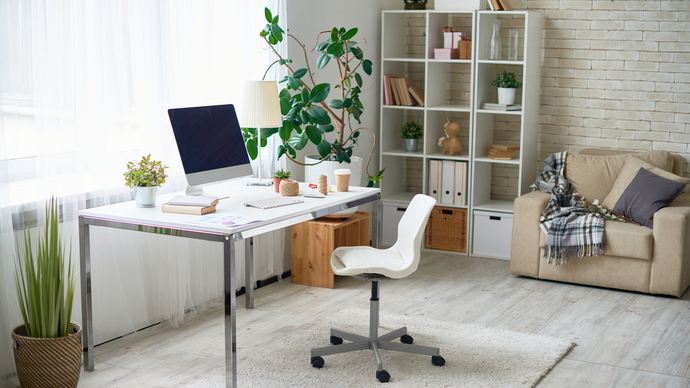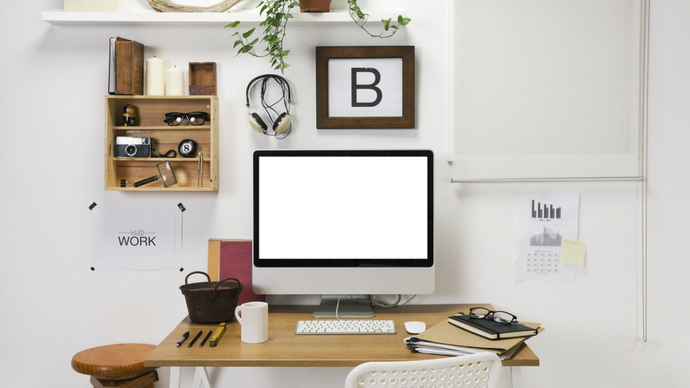As the COVID-19 global health crisis continues, people across the globe are suddenly finding themselves working remotely. For some people, this is a regular practice. But for many, this will be the first time they’ve worked from home or in distributed teams. And this new reality can present challenges.
As people adjust to the new normal, it’s important to find ways of working from home that support their mental, physical and emotional wellbeing. After all, this isn’t a normal remote working scenario, and many people will be struggling with elevated levels of stress and anxiety.
From finding a comfortable space to work to leveraging technology to stay connected with your team, we provide you with practical tips on how to maintain a healthy mind and body while working from home.
Finding a space that works for you
Not everyone has a home office. And if you are finding yourself working from home for the first time, you’ve probably been busy over the last week trying to find a space that allows you to be both comfortable and productive.
Perhaps you’ve always imagined working from your sofa with the dog under your feet. But maybe you’re finding you need a more focused space to work. And a place away from the social areas of your home so you have a separate space to step back into when you clock off for the day.

Here are some practical things to consider when setting up your workspace:
Access to natural light: Natural light is refreshing and energy boosting. So choose a light, bright space near to a window and you’ll see your creativity, productivity and wellbeing improve. It will also help prevent you from straining your eyes.
Good air quality: The Future Workplace Wellness Study found air quality was rated the number one environmental aspect in the workspace that most affects performance, happiness and wellbeing. And almost half of those surveyed reported that poor air quality makes them get sleepier throughout their workday. So choose a space where you can get a good air flow, perhaps near a door or window so that you can let in some fresh air.
“It’s the invisible factors such as air quality and access to natural light that are often overlooked yet provide the greatest influence on workplace wellness, employee productivity and the overall quality of the employee experience.”
Jeanne Meister, Founding Partner, Future Workplace
Comfortable furniture: A supportive, ergonomic chair will help to reduce the risk of back pain and other physical problems that come with sitting in one place for a long period of time. You may find your seating options at home are limited. But there are simple ways to make you feel more comfortable and supported, such as choosing a chair that's the right height for your desk, adding a cushion behind your lower back for lumbar support, and taking care to sit up properly.
Furniture set up: Consider the proximity between you, your furniture and your technology to make sure you can work comfortably and effectively without slouching or over-stretching.

Find focus: Ideally you will want to find a quiet space where you can focus on work without distractions. However, this may not be realistic with other members of the household also at home. So set up signals to show when you’re working and don’t want to be distracted. Or if noise is your issue, then headphones could help you to zone out from the rest of the house.
Move around: Take inspiration from modern workplaces and move between different parts of the home to support different modes of work. Sit at a desk or table for work that requires 100% concentration, get up and move around if you need to mull something over, or take a break on your sofa to recharge you for the next part of your day. One risk of working from home is that you become more sedentary, so be sure to move around and vary your posture throughout the day. Activating your body will also help stop you from going stir crazy.
Personalise your space: Surround yourself with things that make you happy, like an inspiring picture, a plant, or your favourite mug. It might sound silly, but adding a bit of personality and joy to your workspace will brighten your mood and make you more productive too.

Leveraging video technology to stay connected
Even in normal circumstances, one of the biggest things remote workers struggle with is feeling alone or isolated from their team. In the current situation, being isolated from many of your wider family and friends will only exacerbate these feelings.
In this new world, video technology is your best friend. Even outside of work, people across the globe are using tools like Google Hangouts and Houseparty to connect with friends and family. And video should be the default option for communicating with your co-workers too.
If you’ve tried remote collaboration on the phone, you’ll know how difficult it is. People talking over each other, long pauses as people are unsure of whether it's their turn to speak. And that horrible uncertain feeling of not knowing whether someone is excited by what you have to say - or slowly falling asleep. The lack of verbal cues makes it much harder to communicate.
Video removes all of this chaos and ambivalence. Seeing each other’s facial reactions and body language makes it far easier to read the room, which allows for conversations to go faster and more smoothly.
What’s more, scientists demonstrate that eye-to-eye contact helps boost human connection:
“Studies of the neurocognitive mechanisms involved in perceiving and responding to social cues show that seeing another person activates specific parts of the brain called mirror neurons, which react most strongly during face-to-face contact and a little less during video contact. Mirror neurons enable us to “read” other people’s intentions, which fosters mutual understanding and empathy.”
Steelcase
It might be tempting not to turn on your camera over fears of people seeing your unmade bed or messy living room in the background. But you’ll feel a million times better if you’re able to make eye contact with your team.
Here are a few ideas of ways to leverage video technology to stay connected to your team on a daily basis. When you’re in the office, you get many of these checkpoints naturally. When working remotely, you need them even more.
Daily virtual team meetings: It’s easy to lose that sense of being in a team when everyone is working on their own. A quick virtual team video meeting every morning can help you to stay connected with what others are working on and to keep projects moving forward.
Group social interactions: Set aside time for more informal conversations to foster team cohesion and boost morale.
Remote coffee catch ups: Schedule coffee with a colleague over video to catch up on work or non-work related issues.

Finally, bear in mind these practical tips for a better video experience:
Use headphones: Headphones with a built in mic will provide a better experience than computer audio as they will cut out any background noise or interference.
Use the mute button: If you’re late to join a meeting, mute your audio so you avoid disrupting the conversation. Or if you’re mostly listening, put yourself on mute and take yourself off when you want to contribute.
Get your positioning right: Put your computer at eye level so it isn’t looking up your nose or cutting off half your face - it will not only be distracting for your colleagues but for you too. And avoid having your back to a window so you can be seen clearly on the screen.
Summary
As people adjust to the new reality of remote working, they’ll be realising both the benefits and the frustrations. What needs to remain at the forefront of our minds at this time is ensuring we are all adopting practices that support us to stay happy and healthy.
In finding a comfortable workspace, there is no one-size-fits-all solution. And there may be some trial and error involved in finding the best space for you. But having a light, bright, comfortable space to work in, surrounded by things that bring you joy, will make the remote working experience a far more positive one.
Likewise, it may take a bit of time to get used to communicating with your colleagues through a video screen rather than in person. But maintaining that connection is vital for boosting your mental and emotional wellbeing while working remotely.









